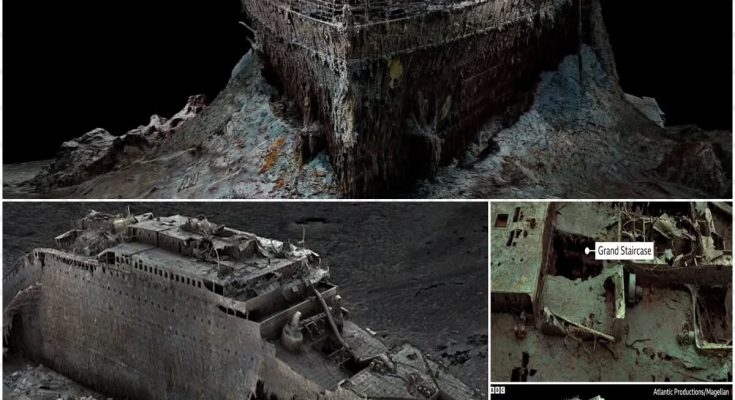A groundbreaking, high-resolution 3D reconstruction of the Titanic wreck has unveiled new clues about the ship’s ill-fated descent into the icy waters of the North Atlantic. Developed by deep-sea mapping specialists at Magellan Ltd, this full-scale digital model offers the most complete look at the wrecked vessel since its discovery. Resting at an almost unfathomable depth of 12,500 feet (3,800 meters), the wreck has been digitally captured from every angle using underwater robots, which gathered over 700,000 images to assemble an accurate “digital twin.”
The RMS Titanic famously went down on April 15, 1912 after striking an iceberg during its maiden voyage. Of the 2,224 passengers and crew on board, 1,517 lost their lives. According to the new simulation, the ship succumbed not to a single large tear in the hull, but rather to a series of six small punctures, each no larger than a sheet of paper. These minor breaches proved devastating, letting in enough water to send the ship to the ocean floor in under three hours.
Titanic researcher Parks Stephenson emphasized the value of seeing the full wreck in one comprehensive three-dimensional model.
“Having a comprehensive view of the entirety of the wreck site is key to understanding what happened here,” he said in an interview with the BBC. “It’s like a crime scene: you need to see what the evidence is, in the context of where it is … Titanic is the last surviving eyewitness to the disaster, and she still has stories to tell.”
The Definitive Destruction Scenario
The 3D scan vividly illustrates how violently the Titanic split apart during its descent. The front half of the ship now rests upright, preserved in a hauntingly intact condition. In contrast, the stern is a chaotic mess of twisted metal, lying about 2,000 feet (600 meters) away after spiraling downward and slamming into the seabed. Between the two sections there is a wide field of debris, which contains down-to-earth traces of human life, personal items of all types including like shoes, furniture, and even unopened bottles of champagne.

View of the bow of the RMS Titanic photographed in June 2004 by the ROV Hercules. (NOAA/Institute for Exploration/University of Rhode Island/Public Domain).
Particular attention has been paid to a boiler room near the rear of the bow section, which is exposed due to where the ship broke apart. The scan reveals that some of the boilers are dented inward, a detail that implies they were operational when submerged. This supports accounts from survivors who described the engineers’ efforts to keep power running as long as possible during the chaos.
A still-open steam valve was also detected in the digital model, indicating that steam was actively flowing through the power systems during the ship’s final moments. “They kept the lights and electricity running until the end, to give the crew time to launch the lifeboats safely with some light instead of in absolute darkness,” Stephenson said.
This act of dedication can be credited to Chief Engineer Joseph Bell and his team, who remained below deck to continue shoveling coal into the furnaces. Their bravery gave passengers a fighting chance at survival, though none of them lived to tell the tale.
“The story of engineer Joseph Bell and his crew sacrificing their lives to save others is still told with reverence,” Stephenson noted.
The scan also revealed the details of a previously misunderstood aspect of the iceberg collision. A damaged porthole appears to be the result of the iceberg’s impact, backing up survivor stories of ice pouring into cabins. While some of the lower bow remains hidden beneath layers of sediment, parts of its distinctive V-shaped structure remain recognizable.

Model of the bow section of the wrecked Titanic. (Kirk/CC BY-SA 4.0).
Simon Benson, an associate lecturer in naval architecture at the University of Newcastle, weighed in on the importance of these subtle hull punctures.
“The difference between Titanic sinking and not sinking are down to the fine margins of holes about the size of a piece of paper,” he noted. This finding challenges the long-standing assumption that a huge sunk the vessel, replacing it with the understanding that a small series of punctures at just the wrong spot was enough to seal the ship’s doom.
The human cost of the tragedy is also starkly visible in the scan. Scattered across the ocean floor are the personal belongings of passengers, modest symbols of the thousands who perished. The Titanic, celebrated in its time for unmatched luxury and engineering, lacked sufficient lifeboats for everyone on board, due in part to outdated maritime regulations. Among the victims were some of the wealthiest people of the era, such as John Jacob Astor IV, Benjamin Guggenheim, and Isidor Straus.
Titanic: The Digital Resurrection
Concerns are mounting among experts that the wreck is decaying at a rapid pace, with predictions that it could completely collapse within the next four decades.
The detailed 3D model now stands as a permanent, high-resolution record of the ship in its current state. “This digital survey not only provides a stunning visual glimpse of the wreck but also renews questions about technology and design in maritime history,” Stephenson commented.
The new scan will take center stage in an upcoming National Geographic and Atlantic Productions documentary, Titanic: The Digital Resurrection. The film will delve into how the ship has been reconstructed and examine the exact damage it suffered. With this project, the Titanic’s tragic legacy is being preserved for future generations while continuing to teach relevant lessons about engineering, safety, and human courage.

The RMS Titanic on the docks of Southampton, just prior to departure on its maiden voyage. (Public Domain).
Although widely considered unsinkable at the time of its construction, the Titanic was only capable of surviving the flooding of four of its watertight compartments. The iceberg punctured six.
“We used advanced numerical algorithms, computational modeling and supercomputing capabilities to reconstruct the Titanic sinking,” said Professor Jeom-Kee Paik of University College London, who led the technical analysis behind the model. While this approach has produced breathtaking results, no digital scan, regardless of how precise, can recreate the sensation of what it would have been like to be on the Titanic on that fateful April night nearly 113 years ago.
“She’s only giving her stories to us a little bit at a time,” Stephenson noted wistfully. “Every time, she leaves us wanting for more.”



